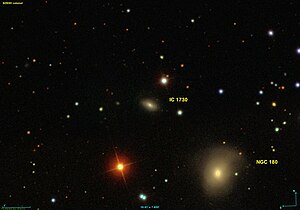IC 1730
| Galaxy IC 1730 |
|
|---|---|

|
|
| AladinLite | |
| Constellation | Aries |
|
Position equinox : J2000.0 , epoch : J2000.0 |
|
| Right ascension | 01 h 49 m 57.9 s |
| declination | + 22 ° 00 ′ 44 ″ |
| Appearance | |
| Morphological type | S0 |
| Brightness (visual) | 14.4 mag |
| Brightness (B-band) | 15.4 mag |
| Angular expansion | 0.8 ′ × 0.5 ′ |
| Position angle | 65 ° |
| Surface brightness | 13.3 mag / arcmin² |
| Physical data | |
| Redshift | 0.009870 ± 0.000077 |
| Radial velocity | 2959 ± 23 km / s |
|
Stroke distance v rad / H 0 |
(137 ± 10) x 10 6 ly (42.0 ± 3.0) Mpc |
| history | |
| discovery | Stéphane Javelle |
| Discovery date | January 17, 1896 |
| Catalog names | |
| IC 1730 • PGC 6732 • CGCG 482-020 • MCG + 04-05-015a • 2MASX J01495792 + 2200440 • GALEX ASC J014957.86 + 220043.5 | |
IC 1730 is a lenticular galaxy of the Hubble type S0 in the constellation Aries in the northern sky . It is estimated to be 137 million light years away from the Milky Way and has a diameter of about 30,000 ly.
In the same area of the sky are the galaxies NGC 678 , NGC 680 , NGC 694 , IC 167 .
The object was discovered by Stéphane Javelle on January 17, 1896 .
